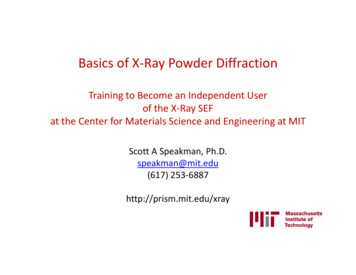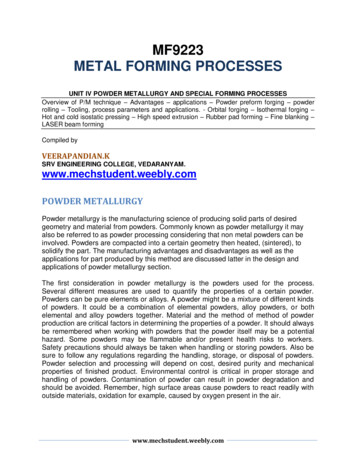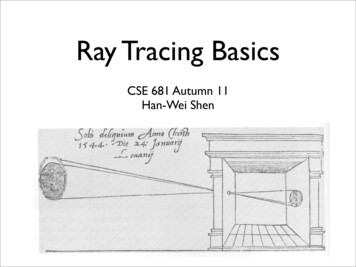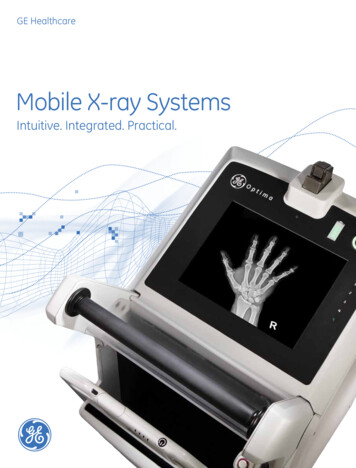
Transcription
Basics of X-Ray Powder DiffractionTraining to Become an Independent Userof the X-Ray SEFat the Center for Materials Science and Engineering at MITScott A Speakman, Ph.D.speakman@mit.edu(617) 253-6887http://prism.mit.edu/xray
Required Training to Become anIndependent User in the X-Ray SEF
Required Safety Training All users must complete the EHS X-ray Safety trainingAll users must complete the X-ray Lab Specific Safety TrainingAll users must complete the MIT chemical hygiene trainingAll users must be up to date on their MIT managing hazardouswaste training All users must be registered in CMSE MUMMS– https://cmse-coral.mit.edu/mumms/home.html
Instrument Specific Training These courses cover how to safely operate instruments tocollect data Powder Diffractometers:– PANalytical X’Pert Pro Multipurpose Powder Diffractometer– Rigaku High-Power Powder Diffractometer– Bruker D8 with GADDS 2-dimensional detector Other instruments– Bruker D8 HRXRD– XRF
Data Analysis Workshops Basic XRPD Data Analysis using HighScore Plus– Primary focus is on phase identification, with some discussion onadvanced topics such as lattice parameter and crystallite size calculations Profile Fitting and Crystallite Size Determination– Profile fitting is the most precise way to determine diffraction peakposition, intensity, and width for calculating lattice parameters andcrystallite size Rietveld Refinement– The Rietveld method is used to refine the crystal structure model of amaterial. It can be used for quantitative phase ID, lattice parameter andcrystallite size calculations, and determine atom positions andoccupancies
High Resolution X-Ray Diffraction (HRXRD) Training HRXRD is used to analyze epitaxial thin films– Can determine composition, strain/relaxation, lattice parameters (inplane and out-of-plane), thickness, and defect concentration X-Ray Reflectivity (XRR) is used to analyze thin films, includingamorphous and non-textured films– Can determine thickness, roughness, and density Introduction Lecture Instrument training on the Bruker HRXRD HRXRD Data Analysis Workshop
Introduction to Crystallography andX-Ray Diffraction Theory
Diffraction occurs when light is scattered by a periodic array withlong-range order, producing constructive interference atspecific angles. The electrons in an atom coherently scatter light.– We can regard each atom as a coherent point scatterer– The strength with which an atom scatters light is proportional to the numberof electrons around the atom. The atoms in a crystal are arranged in a periodic array and thus candiffract light. The wavelength of X rays are similar to the distance betweenatoms. The scattering of X-rays from atoms produces a diffractionpattern, which contains information about the atomicarrangement within the crystal Amorphous materials like glass do not have a periodic array with long-rangeorder, so they do not produce a diffraction pattern
The figure below compares the X-ray diffractionpatterns from 3 different forms of SiO2Counts4000SiO2 000020 50These three phases of SiO2 are chemically identicalQuartz and cristobalite have two different crystal structures–– 3040Position [ 2Theta] (Copper (Cu))The Si and O atoms are arranged differently, but both have structures with long-range atomic orderThe difference in their crystal structure is reflected in their different diffraction patternsThe amorphous glass does not have long-range atomic order and therefore producesonly broad scattering peaks
The diffraction pattern is a product of the uniquecrystal structure of a materialQuartzCristobalite The crystal structure describes the atomic arrangement of a material. When the atoms are arranged differently, a different diffraction pattern isproduced (ie quartz vs cristobalite)
Crystalline materials are characterized by the longrange orderly periodic arrangements of atoms. The unit cell is the basic repeating unit that defines the crystal structure.– The unit cell contains the maximum symmetry that uniquely defines the crystalstructure.– The unit cell might contain more than one molecule: for example, the quartz unit cell contains 3 complete molecules of SiO2.Crystal System: hexagonalLattice Parameters:4.9134 x 4.9134 x 5.4052 Å(90 x 90 x 120 ) The crystal system describes the shape of the unit cell The lattice parameters describe the size of the unit cell The unit cell repeats in all dimensions to fill space and produce themacroscopic grains or crystals of the material
Crystal structures focus on symmetry elements todefine the atomic arrangement Symmetry in crystal structures is a product of energyminimization in the atomic arrangement Symmetry in the crystal structure often produces symmetry inmaterial properties and behaviorQuartzCrystal System: hexagonalBravais Lattice: primitiveSpace Group: P3221Lattice Parameters: 4.9134 x 4.9134 x 5.4052 Å(90 x 90 x 120 )Atom Positions:xyzSi0.4700.667O0.4140.2680.786Primitive Bravais Lattice32 screw axis2-fold rotational axis
Symmetry elements are used to define seven differentcrystal systemsCrystal SystemBravaisLatticesSymmetryAxis SystemCubicP, I, Fm3ma b c, α β γ 90TetragonalP, I4/mmma b c, α β γ 90HexagonalP, R6/mmma b c, α β 90 γ 120Rhombohedral*R3ma b c, α β γ 90OrthorhombicP, C, I, Fmmma b c, α β γ 90MonoclinicP, C2/ma b c, α γ 90 β 90TriclinicP1a b c, α β γ 90QuartzCrystal System: hexagonalBravais Lattice: primitiveSpace Group: P3221Lattice Parameters: 4.9134 x 4.9134 x 5.4052 Å(90 x 90 x 120 )
112Diffraction peaks are associated with planes of atoms0031020111120011020102Calculated Profile 00-005-0490035404550Position [ 2Theta] (Copper (Cu)) Miller indices (hkl) are used to identify different planes of atoms Observed diffraction peaks can be related to planes of atoms toassist in analyzing the atomic structure and microstructure of asample
Parallel planes of atoms intersecting the unit cell definedirections and distances in the crystal.The (200) planesof atoms in NaCl The (220) planesof atoms in NaClThe Miller indices (hkl) define the reciprocal of the axial interceptsThe crystallographic direction, [hkl], is the vector normal to (hkl)dhkl is the vector extending from the origin to the plane (hkl) and is normal to(hkl)The vector dhkl is used in Bragg’s law to determine where diffraction peaks willbe observed
Useful things to remember about Miller indices (hkl) is parallel to (n*h n*k n*l) When analyzing XRD data, we look fortrends corresponding to directionality inthe crystal structure by analyzing the Millerindices of diffraction peaks.004112202 [h00] is parallel to the a-axis, [0k0] // b-axis,[00l] // c-axis103– In a cubic crystal, (100) (010) and (001) areequivalent– They are the family of planes {100}102100002101 Planes are orthogonal if (hkl) (h’k’l’) 0 Some planes may be equivalent because ofsymmetry110– For example, (110) // (220) // (330) // (440) 03040506070Position [ 2Theta] (Copper (Cu))In this figure, the (002) and (004) peaks(which are parallel to each other) aremuch more intense than expected– thisprovides information about themicrostructure of the sample
The position and intensity of peaks in a diffractionpattern are determined by the crystal structureCounts4000SiO2 0000203040Position [ 2Theta] (Copper (Cu))50The diffraction peak position is recorded as the detector angle, 2θ.
The position of the diffraction peaks are determined bythe distance between parallel planes of atoms.Bragg’s Lawλ 2d hkl sin θ Bragg’s law calculates the angle where constructive interferencefrom X-rays scattered by parallel planes of atoms will produce adiffraction peak.– In most diffractometers, the X-ray wavelength λ is fixed.– Consequently, a family of planes produces a diffraction peak only at a specificangle 2θ. dhkl is the vector drawn from the origin of the unit cell to intersect thecrystallographic plane (hkl) at a 90 angle.– dhkl, the vector magnitude, is the distance between parallel planes of atoms in thefamily (hkl)– dhkl is a geometric function of the size and shape of the unit cell
The intensity of the diffraction peaks are determined by thearrangement of atoms in the entire crystal ܫ ܨ mଶ[]Fhkl N j f j exp 2πi (hx j ky j lz j )j 1 The structure factor Fhkl sums the result of scattering from all of theatoms in the unit cell to form a diffraction peak from the (hkl) planesof atoms The amplitude of scattered light is determined by:– where the atoms are on the atomic planes this is expressed by the fractional coordinates xj yj zj– what atoms are on the atomic planes the scattering factor fj quantifies the efficiency of X-ray scattering at anyangle by the group of electrons in each atom– The scattering factor is equal to the number of electrons around the atom at 0 θ,the drops off as θ increases Nj is the fraction of every equivalent position that is occupied by atom j
Bragg’s law provides a simplistic model to understandwhat conditions are required for diffraction.s[hkl] For parallel planes of atoms, with a space dhkl between the planes, constructiveinterference only occurs when Bragg’s law is satisfied.–– θdhkl dhklλ 2d hkl sin θθIn our diffractometers, the X-ray wavelength λ is fixed.Consequently, a family of planes produces a diffraction peak only at a specific angle 2θ.Additionally, the plane normal [hkl] must be parallel to the diffraction vector s––Plane normal [hkl]: the direction perpendicular to a plane of atomsDiffraction vector s: the vector that bisects the angle between the incident and diffracted beam
Our powder diffractometers typically use the BraggBrentano geometry.DetectorsX-raytubeω The incident angle, ω, is defined between the X-ray source and the sample.The diffraction angle, 2θ, is defined between the incident beam and the detector.The incident angle ω is always ½ of the detector angle 2θ .–– 2θIn a θ:2θ instrument (e.g. Rigaku H3R), the tube is fixed, the sample rotates at θ /min and thedetector rotates at 2θ /min.In a θ:θ instrument (e.g. PANalytical X’Pert Pro), the sample is fixed and the tube rotates at a rate -θ /min and the detector rotates at a rate of θ /min.In the Bragg-Brentano geometry, the diffraction vector (s) is always normal to thesurface of the sample.–The diffraction vector is the vector that bisects the angle between the incident and scattered beam
A single crystal specimen in a Bragg-Brentano diffractometer wouldproduce only one family of peaks in the diffraction pattern.[110][100][200]sss2θθAt 20.6 2θ, Bragg’s lawfulfilled for the (100) planes,producing a diffraction peak.The (110) planes would diffract at 29.3 2θ; however, they are not properlyaligned to produce a diffraction peak(the perpendicular to those planes doesnot bisect the incident and diffractedbeams). Only background is observed.The (200) planes are parallel to the (100)planes. Therefore, they also diffract for thiscrystal. Since d200 is ½ d100, they appear at42 2θ.
A polycrystalline sample should contain thousands of crystallites.Therefore, all possible diffraction peaks should be observed.[200][110][100]ss2θθs2θθ2θθ For every set of planes, there will be a small percentage of crystallites that are properlyoriented to diffract (the plane perpendicular bisects the incident and diffracted beams). Basic assumptions of powder diffraction are that for every set of planes there is an equalnumber of crystallites that will diffract and that there is a statistically relevant number ofcrystallites, not just one or two.
Powder diffraction is more aptly named polycrystallinediffraction Samples can be powder, sintered pellets, coatings on substrates, engine blocks.The ideal “powder” sample contains tens of thousands of randomly orientedcrystallites– Every diffraction peak is the product of X-rays scattering from an equalnumber of crystallites– Only a small fraction of the crystallites in the specimen actually contribute tothe measured diffraction pattern XRPD is a somewhat inefficient measurement technique Irradiating a larger volume of material can help ensure that a statistically relevantnumber of grains contribute to the diffraction pattern– Small sample quantities pose a problem because the sample size limits thenumber of crystallites that can contribute to the measurement
X-rays are scattered in a sphere around the sample A cone along the sphere corresponds to a single Bragg angle 2theta– The tens of thousands of randomly oriented crystallites in an ideal sampleproduce a Debye diffraction cone.The linear diffraction pattern is formed as the detector scans through an arc thatintersects each Debye cone at a single point; thus giving the appearance of adiscrete diffraction peak.
X-Ray Powder Diffraction (XRPD) is a somewhatinefficient measurement technique Only a small fraction of crystallites in the sample actuallycontribute to the observed diffraction pattern– Other crystallites are not oriented properly to produce diffraction fromany planes of atoms– You can increase the number of crystallites that contribute to themeasured pattern by spinning the sample Only a small fraction of the scattered X-rays are observed bythe detector– A point detector scanning in an arc around the sample only observesone point on each Debye diffraction cone– You can increase the amount of scattered X-rays observed by using alarge area (2D) detector
Area (2D) Diffraction allows us to image complete orincomplete (spotty) Debye diffraction ringsthe area observed by a linear detectorPolycrystalline thin film on asingle crystal substratethe area observed by a linear detectorMixture of fine and coarse grainsin a metallic alloyConventional linear diffraction patterns would missinformation about single crystal or coarse grained materials
Non-Ideal Samples: a “spotty” diffraction pattern The sample does not contain tens of thousands of grains– The Debye diffraction cone is incomplete because there are not astatistically relevant number of grains being irradiatedMount3 07203040Position [ 2Theta] (Copper (Cu))The poor particle statistics cause randomerror in the observed diffraction peakintensities.50
Non-ideal samples: Texture (i.e. preferredcrystallographic orientation) The samples consists of tens of thousands of grains, but thegrains are not randomly oriented– Some phenomenon during crystallization and growth, processing, orsample preparation have caused the grains to have preferredcrystallographic direction normal to the surface of the 40(040)45(041)JCS#98 CaCO3 - Aragonite(132)(113)(212)(042)(222)50Two-Theta (deg)The preferred orientation creates asystematic error in the observeddiffraction peak intensities.55
Diffraction patterns are collected as 2θ vs absolute intensity, butare best reported as dhkl vs relative intensity. The peak position as 2θ depends on instrumental characteristics such aswavelength.– The peak position as dhkl is an intrinsic, instrument-independent, materialproperty. Bragg’s Law is used to convert observed 2θ positions to dhkl. The absolute intensity, i.e. the number of X rays observed in a given peak,can vary due to instrumental and experimental parameters.– The relative intensities of the diffraction peaks should be instrumentindependent. To calculate relative intensity, divide the absolute intensity of every peak by theabsolute intensity of the most intense peak, and then convert to a percentage. Themost intense peak of a phase is therefore always called the “100% peak”.– Peak areas are much more reliable than peak heights as a measure ofintensity.
Powder diffraction data consists of a record of photonintensity versus detector angle 2θ. Diffraction data can be reduced to a list of peak positions and intensities– Each dhkl corresponds to a family of atomic planes {hkl}– individual planes cannot be resolved- this is a limitation of powder diffraction versussingle crystal diffractionRaw DataReduced dI listPosition[ 600160040002530354045Position [ 2Theta] (Copper (Cu))dhkl (Å)RelativeIntensity(%){012} 3.493549.8{104} 2.558385.8{110} 2.385236.1{006} 2.17011.9{113} 2.0903100.0{202} 1.96801.4
Applications of XRPD
You can use XRD to determine Phase Composition of a Sample– Quantitative Phase Analysis: determine the relative amounts of phases in amixture by referencing the relative peak intensities Unit cell lattice parameters and Bravais lattice symmetry– Index peak positions– Lattice parameters can vary as a function of, and therefore give youinformation about, alloying, doping, solid solutions, strains, etc. Residual Strain (macrostrain) Crystal Structure– By Rietveld refinement of the entire diffraction pattern Epitaxy/Texture/Orientation Crystallite Size and Microstrain– Indicated by peak broadening– Other defects (stacking faults, etc.) can be measured by analysis of peakshapes and peak width We have in-situ capabilities, too (evaluate all properties above as afunction of time, temperature, and gas environment)
Phase Identification The diffraction pattern for every phase is as unique as your fingerprint– Phases with the same chemical composition can have drastically differentdiffraction patterns.– Use the position and relative intensity of a series of peaks to matchexperimental data to the reference patterns in the database
The diffraction pattern of a mixture is a simple sum ofthe scattering from each component phase
Databases such as the Powder Diffraction File (PDF) contain dIlists for thousands of crystalline phases. The PDF contains over 300,000 diffraction patterns. Modern computer programs can help you determine what phases arepresent in your sample by quickly comparing your diffraction data to all ofthe patterns in the database. The PDF card for an entry contains a lot of useful information, includingliterature references.
Quantitative Phase AnalysisWith high quality data, you can determine howmuch of each phase is present– must meet the constant volume assumption (seelater slides) The ratio of peak intensities varies linearly as afunction of weight fractions for any two phasesin a mixture–ூಉூಊ K* ಉ ಊ– need to know the constant of proportionality RIR method is fast and gives semi-quantitativeresults– ܭ ோூோಉ60I(p h a s e a )/I(p h a s e b ) . 5040302010000.20.40.6ோூோಊWhole pattern fitting/Rietveld refinement is amore accurate but more complicated analysisX(phase a)/X(phase b)0.81
Unit Cell Lattice Parameter Refinement By accurately measuring peak positions over a long range of2theta, you can determine the unit cell lattice parameters ofthe phases in your sample– alloying, substitutional doping, temperature and pressure, etc cancreate changes in lattice parameters that you may want to quantify– use many peaks over a long range of 2theta so that you can identifyand correct for systematic errors such as specimen displacement andzero shift– measure peak positions with a peak search algorithm or profile fitting profile fitting is more accurate but more time consuming– then numerically refine the lattice parameters
Crystallite Size and Microstrain Crystallites smaller than 120nm create broadening of diffraction peaks– this peak broadening can be used to quantify the average crystallite size ofnanoparticles using the Scherrer equation– must know the contribution of peak width from the instrument by using a calibrationcurvemicrostrain may also create peak broadening– analyzing the peak widths over a long range of 2theta using a Williamson-Hull plotcan let you separate microstrain and crystallite size00-043-1002 Cerianite- - CeO2KλB(2θ ) L cos θIntensity (a.u.) 23 24 25 26 27 28 29 30 31 32 33 34 35 36 37 38 39 40 412θ (deg.)
Preferred Orientation (texture) Preferred orientation of crystallites can create a systematicvariation in diffraction peak intensities– can qualitatively analyze using a 1D diffraction pattern– a pole figure maps the intensity of a single peak as a function of tiltand rotation of the sample this can be used to quantify the texture10.000-004-0784 Gold - 22)2.0(400)x10340506070Two-Theta (deg)8090100
Overview of the Diffractometer
Essential Parts of the Diffractometer X-ray Tube: the source of X Rays Incident-beam optics: condition the X-ray beam before it hitsthe sample The goniometer: the platform that holds and moves thesample, optics, detector, and/or tube The sample & sample holder Receiving-side optics: condition the X-ray beam after it hasencountered the sample Detector: count the number of X Rays scattered by the sample
X-radiation for diffraction measurements is producedby a sealed tube or rotating anode. Sealed X-ray tubes tend to operate at 1.8to 3 kW.Rotating anode X-ray tubes producemuch more flux because they operate at9 to 18 kW.– A rotating anode spins the anode at 6000rpm, helping to distribute heat over alarger area and therefore allowing thetube to be run at higher power withoutmelting the target. Both sources generate X rays by strikingthe anode target with an electron beamfrom a tungsten filament.H2O InH2O ode)metalglass(vacuum)(vacuum)– The target must be water cooled.– The target and filament must becontained in a vacuum.AC CURRENT
The wavelength of X rays is determined by the anode ofthe X-ray source. Electrons from the filament strike the target anode, producing characteristicradiation via the photoelectric effect.The anode material determines the wavelengths of characteristic radiation.While we would prefer a monochromatic source, the X-ray beam actuallyconsists of several characteristic wavelengths of X rays.KLM
Spectral Contamination in Diffraction PatternsKα1Kα1Kα2Kα2Kα1Kα2KβW Lα1 The Kα1 & Kα2 doublet will almost always be present– Very expensive optics can remove the Kα2 line– Kα1 & Kα2 overlap heavily at low angles and are more separatedat high angles W lines form as the tube ages: the W filament contaminatesthe target anode and becomes a new X-ray source W and Kβ lines can be removed with optics
Monochromators remove unwanted wavelengths of radiationfrom the incident or diffracted X-ray beam. Diffraction from a crystal monochromator can be used toselect one wavelength of radiation and provide energydiscrimination. An incident-beam monochromator might be used to selectonly Ka1 radiation for the tube source. A diffracted-beam monochromator, such as on the RigakuRU300, may be used to remove fluoresced photons, Kb, or Wcontimination photons from reaching the detector.– Without the RSM slit, the monochromator removes 75% of unwantedwavelengths of radiation.– When the RSM slit is used, over 99% of the unwanted wavelengths ofradiation can be removed from the beam.
Beta filters can also be used to reduce the intensity ofK-beta and W wavelength radiation Cu K-alpha 1.541 Å Cu K-beta 1.387 Å The Ni absorption edge 1.488 Å– The Ni absorption of Cu raidationis: 50% of Cu K-alpha 99% of Cu K-betaWavelengthCu KβW LαCu Kα– For example, when using CuradiationNi filterSuppression A material with an absorptionedge between the K-alpha andK-beta wavelengths can beused as a beta filter This is often the element justbelow the target material onthe periodic table
HFluorescenceLi BeNa MgK Ca Sc TiHeBCNOAl SiPS Cl ArV Cr Mn Fe Co Ni Cu Zn Ga Ge As Se Br KrRb Sr Y Zr Nb Mo Tc Ru Rh Pd Ag Cd In Sn Sb TeCs Ba LF NeHf Ta W Re Os IrIPt Au Hg Tl Pb Bi Po At RnFr Ra A Some atoms absorb incident X-rays and fluoresce them as X-rays of a differentwavelength–– The absorption of X-rays decreases the diffracted signalThe fluoresced X-rays increase the background noiseThe increased background noise from fluoresced X-rays can be removed by using:––a diffracted-beam monochromatoran energy sensitive detectorThe diffracted beam signal can only be increased by using a different wavelength ofradiationThe most problematic materials are those two and three below the target material:–XeFor Cu, the elements that fluoresce the most are Fe and Co
The X-ray Shutter is the most important safety deviceon a diffractometer X-rays exit the tube through X-raytransparent Be windows.H2O InH2O OutXRAYSBewindowCu X-Ray safety shutters contain thebeam so that you may work in thediffractometer without being exposedto the rFILAMENT(cathode)Solenoidmetalglass(vacuum) Being aware of the status of theshutters is the most important factorin working safely with X rays.ANODE(vacuum)AC CURRENT
The X-ray beam produced by the X-ray tube is divergent.Incident-beam optics are used to limit this divergenceλ 2d hkl sin θ X Rays from an X-ray tube are:– divergent– contain multiple characteristic wavelengths as well as Bremmsstrahlung radiation neither of these conditions suit our ability to use X rays for analysis– the divergence means that instead of a single incident angle q, the sample is actuallyilluminated by photons with a range of incident angles.– the spectral contamination means that the smaple does not diffract a single wavelengthof radiation, but rather several wavelengths of radiation. Consequently, a single set of crystallographic planes will produce several diffraction peaksinstead of one diffraction peak. Optics are used to:– limit divergence of the X-ray beam– refocus X rays into parallel paths– remove unwanted wavelengths
Most of our powder diffractometers use the BraggBrentano parafocusing geometry. A point detector and sample aremoved so that the detector is alwaysat 2θ and the sample surface isalways at θ to the incident X-raybeam. In the parafocusing arrangement, theincident- and diffracted-beam slitsmove on a circle that is centered onthe sample. Divergent X rays from thesource hit the sample at differentpoints on its surface. During thediffraction process the X rays arerefocused at the detector slit. This arrangement provides the bestcombination of intensity, peak shape,and angular resolution for the widestnumber of samples.F: the X-ray sourceDS: the incident-beam divergence-limiting slitSS: the Soller slit assemblyS: the sampleRS: the diffracted-beam receiving slitC: the monochromator crystalAS: the anti-scatter slit
Divergence slits are used to limit the divergence of theincident X-ray beam. The slits block X-rays that have too great adivergence. The size of the divergence slit influencespeak intensity and peak shapes. Narrow divergence slits:– reduce the intensity of the X-ray beam– reduce the length of the X-ray beam hittingthe sample– produce sharper peaks the instrumental resolution is improved sothat closely spaced peaks can be resolved.
One by-product of the beam divergence is that the length of the beamilluminating the sample becomes smaller as the incident anglebecomes larger. The length of the incident beamis determined by the divergenceslit, goniometer radius, andincident angle.This should be considered whenchoosing a divergence slits size:The width of the beam isconstant: 12mm for the RigakuRU300.35.00Le 30.00ng 25.00th 20.00Irradia15.00tmem 10.00d) 40.002 DS1 DS(– if the divergence slit is too large,the beam may be significantlylonger than your sample at lowangles– if the slit is too small, you maynot get enough intensity fromyour sample at higher angles– Appendix A in the SOP contains aguide to help you choose a slitsize.185mm Radius Goniometer, XRPD0.5 DS5.000.15 DS0.0002040602Theta (deg)80100
Other optics: limit divergence of the X-ray beam– Divergence limiting slits– Parallel plate collimators– Soller slits refocus X rays into parallel pathsParallel Plate Collimator & SollerSlits block divergent X-rays, butdo not restrict beam size like adivergent slit– “parallel-beam optics”– parabolic mirrors and capillary lenses– focusing mirrors and lenses remove unwanted wavelengths– monochromators– Kβ filtersGöbel Mirrors and capillary lenses collecta large portion of the divergent beam andrefocus it into a nearly parallel beam
Detectors point detectors– observe one point of space at a time slow, but compatible with most/all optics– scintillation and gas proportional detectors count all photons, within anenergy window, that hit them– Si(Li) detectors can electronically analyze or filter wavelengths position sensitive detectors– linear PSDs observe all photons scattered along a line from 2 to 10 long– 2D area detectors observe all photons scattered along a conic section– gas proportional (gas on wire; microgap anodes) limited resolution, issues with deadtime and saturation– CCD limited in size, expensive– solid state real-time multiple semiconductor strips high speed with high resolution, robust
Instruments in the X-Ray SEFat the Center for Material Science andEngineering at MIT
Rigaku Powder Diffractometers Fast, precision XRPD using theta/2theta motionHigh-power (18kW) rotating anode source supplies high X ray fluxDiffracted-beam monochromators provide very good signal-to-noise ratioTwo horizontal-circle powder diffractometers–––– The H3R generator provides Cu wavelength radiation and a 185mm radiusThe RU300 generator provides Cr wavelength radiation and a 185mm radiusHorizontal circle facilitates precision movement of goniometerDisadvantage: sample sits vertical, can easily fall out of sample holderSample size is generally 20mm x 10mm x 0.3mm, though we have a variety ofsample holders and mounting procedures to accommodate varied sampl
Basics of X-Ray Powder Diffraction Training to Become an Independent User of the X-Ray SEF a










